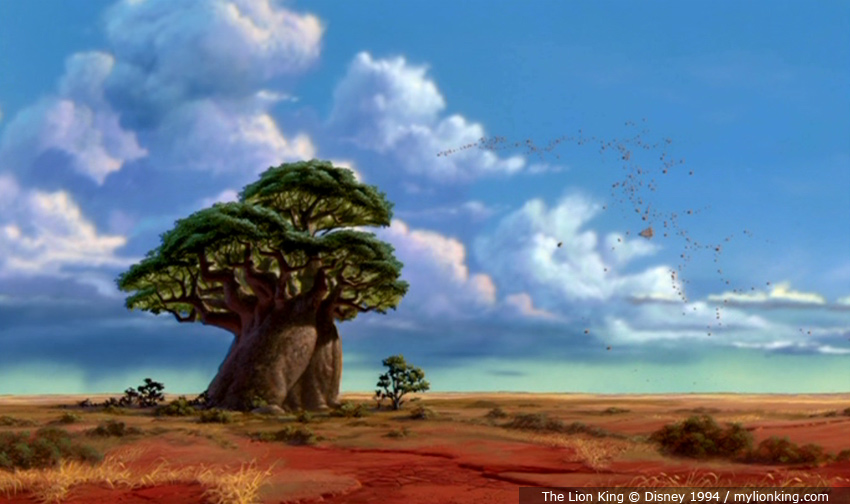So, these are things I noticed about this film a few months ago while I was watching it on TV. I haven't researched any of it to find if it's valid or if it was even intentional. However, when I started putting all these things together it blew my mind so completely that I jumped out of my chair and ran off to find someone I could share my insights with. That person ended up being my roommate. Bless her heart for so patiently listening to the insane ramblings of an art student. Especially since I was so excited about my discovery that I nearly tripped over all my words and mostly shouted "COLOR THEORY.....RED!....BLUE! IT'S SO AMAZING!!!!"
Let's start with Mufasa. He is an orange colored lion and whenever he is seen on screen he has a backdrop of blue. The only exceptions to this rule are when he has encounters with his brother, Scar. When these encounters happen the background changes to stone. (Maybe because he and Scar have a ROCKY relationship!!) So, orange and blue are complementary colors with orange symbolizing wisdom, warmth, happiness, and assurance and blue symbolizing loyalty, tradition, calmness, and trust. All of these attributes explain Mufasa's personality and on a deeper level are just what a child needs in order to grow up to become a competent adult.
Scar on the other hand is always seen in the shadows. When he isn't lurking and actually steps out of the shadows the sky is overcast or otherwise obscured. He is also most frequently depicted with secondary colors: purple, orange, and green...also yellow but the shade of yellow used has a greenish tint to it. Secondary colors are very frequently used for villains as they give off a spooky and menacing vibe. This is also why witches costumes during Halloween are usually secondary colors.
Timon and Pumbaa both belong in the red family and they live in a very green and lush environment. Some of the MANY things red symbolizes are: love, compassion, rescue, and pain. Green often symbolizes growth, hope, and youth. So Timon and Pumbaa literally rescue Simba from death. They have compassion over his sadness and allow him to grow up in safety.
I have come to think of this movie in parts and I think the colors used help block things out perfectly. You start out with orange and blue as a symbol of Simba's childhood. When the song "I Just Can't Wait to be King" is played the colors become over saturated as a symbol of the height of innocent youth. This sequence is followed by the stark grays of the elephant graveyard. This is showing the audience that the innocence is over and it's time to grow up. Those bright colors will never be seen again for the remainder of the film. Green and red take over the the latter part of the movie to show that Simba is going through adolescence. In the part following Simba's conversation with Timon and Pumbaa about the stars, Simba falls to the ground with a heavy sigh, sending up a puff of dust which floats across the desert and finds their way to Rafiki. Notice how it is that as the dust floats across the screen the colors in the background are red, green, orange, and blue. I take this as the past catching up to Simba: it's time to face it and become a whole and functioning adult. And the conclusion comes with more stark grays as a symbol of death followed by rain and a renewal of the Circle of Life.

Can you see why I say this movie is a complete masterpiece?! The colors alone tell the whole story of Simba's journey from child to adult. Of course there are other amazing things done visually throughout this movie. I love the nod to fascist propaganda during the song "Be Prepared." Another favorite moment of mine is when Mufasa is explaining to Simba that the stars are the "great kings of the past." I love that he shares this insight just after the sun has set. It is such a fabulous foreshadowing that the sun is setting on Mufasa's time as king and he will soon join his ancestors in the stars.
And of course, here's a miscellaneous thought for you to mull over: Is Simba a vegetarian?
Next time we'll talk about the Colors of the Wind and other things I learned about Native Americans while watching Pocahontas.
Nice! Never stopped to think so much about that stuff.
ReplyDeleteAlso, I think the stampede scene is one of the most powerful adrenaline scenes in animation. There's nothing like it in any other animated film.